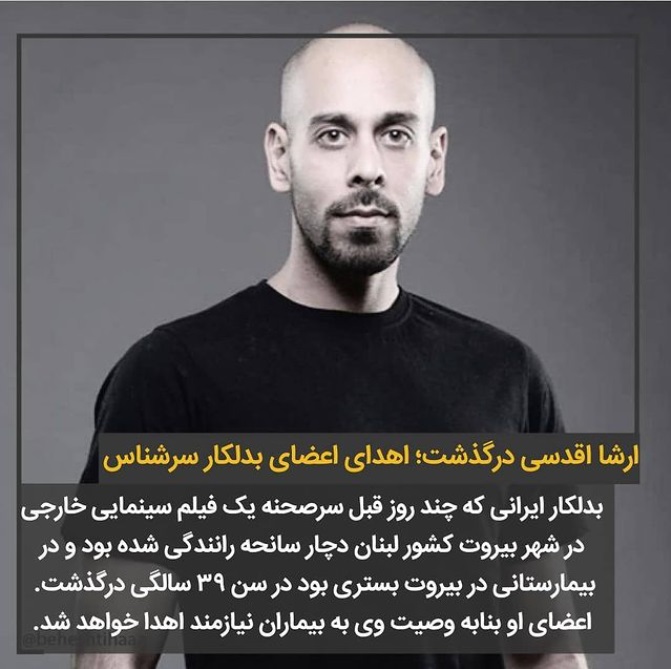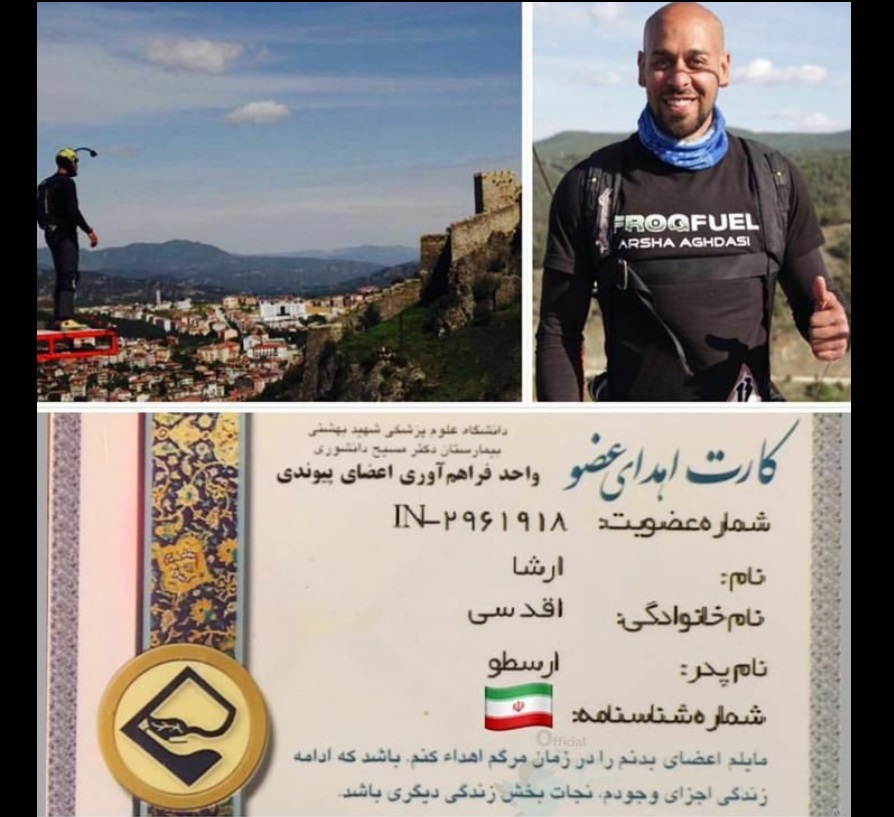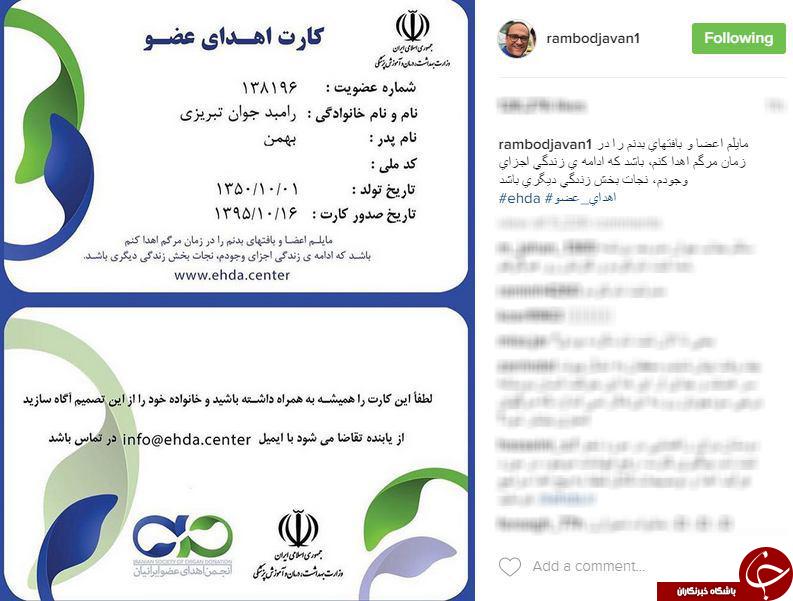
اهدای زندگی Life Donation
به نام خدا، مطالبی راجع به اهدای عضو-اهدای سلولهای بنیادی-اهدای خون-اهدای پلاکت-اهدای پلاسما با همکاری کانون اهدای زندگی دانشگاه بناب--- آدرس صفحه اینستاگرام: ehda.zendeghi@
اهدای زندگی Life Donation
به نام خدا، مطالبی راجع به اهدای عضو-اهدای سلولهای بنیادی-اهدای خون-اهدای پلاکت-اهدای پلاسما با همکاری کانون اهدای زندگی دانشگاه بناب--- آدرس صفحه اینستاگرام: ehda.zendeghi@اندیشه والای زنده یاد ارشا اقدسی در خصوص اهدای عضو
اندیشه والای زنده یاد ارشا اقدسی در خصوص اهدای عضو، حاکی از قلب مهربان و روح بزرگ ایشان بود. روحش شاد و یادش گرامی


Donation card of the presenter of "Khandvaneh", Rambod Javan
Rambod Javan Tabrizi volunteered for organ donation in a humanitarian practice (Date of this news : 2017 January 8).
Young Journalists Club: "Organ Donatin, Life Donation". You must have heard this slogan a lot. It is both bitter and soothing. It is bitter for a mother who does not want to believe that her child's life's office in this world is closed, and at the same time the sound of her beating in another body can be soothing. Rambod Javan Tabrizi, the famous presenter of Khandvaneh program, was among those who joined the group of registered donors and shared a photo of his donation card on his instagram page.
"I would like to donate my organs and tissues at the time of my death, so that the continuation of my life will save another life."

Persian page link : https://ehda-zendeghi.blogsky.com
Translator : Javad Eynaki Maleki
Organ donation after brain death or cardiac death (typical death)
With the consent of the parents, all those who have suffered from brain death or cardiac death (normal death) can have their organs removed and transplanted into patients. All over the world, a few decades ago, brain death was considered equivalent to definite death, and in our country, according to the law (approved in 1379), brain death is equivalent to death. According to the same law, organs are allowed to be removed from cases of brain death as well as cardiac death with the consent of the family and its transplantation.
Organ donation after brain death:
The main human organs such as the heart, lungs, liver, kidney ... due to having the main blood vessels are destroyed as soon as they die. Therefore, these organs can only be removed from cases of brain death, and after removal, they can be stored for a short time and must be transplanted immediately. The donor should not have AIDS, hepatitis or cancer and should not be older than 60 years.
Organ donation after cardiac death:
Tissues such as bones, heart valves, tendons, corneas, etc. live longer and can be removed after normal death (cardiac death) and can be stored for years. Therefore, in cases of death (cardiac death), if the person does not have an infectious disease and timely information and consent is given, the tissue can be removed. The donor should not have AIDS, hepatitis or cancer and should not be older than 60 years.
----------------------------------------------------------------------------------------
Difference between brain death and coma:
Brain death is a state that the brain goes away and dies, but because the spinal cord is alive, the rest of the members (such as the heart) remain alive for a few days; In this case, the person's breathing is discontinued and there is no medical reflection of the individual's improvement or alive, and as soon as the devices are disconnected and the person dies, and with the device and medical care, there are only a few days of "vegetative state" for the individual.
Brain death differs with anesthesia or coma, and most of the accidents occur. To confirm brain death in Iran, they will keep watching 24 hours, and after a variety of experiments and approval of the six specialist appointed by the Minister and Forensic Medicine, and the work of transplantation should be done only in government universities.
Transplant recipients:
Transplant recipients are placed on the waiting list based on blood group, intensity of need and waiting time, and at the same time as the family consent of the deceased for organ donation, a number of transplant recipients will be examined in terms of size and weight and tissue matching tests to make the organ the most suitable person.
Transplant cost:
For a member or tissue, there is no way to pay a donor or receive a recipient, but it is costing for surgical procedures and member maintenance and experiments that are covered by insurance, and the government is paying most costs.
In the operation of organ harvesting from the deceased, the body is not mutated and replaced with the harvested prosthetic organ so that the shape of the body does not change.
Having a member card donor and written will is not enough! Family satisfaction is required:
It is imperative that even if the family consent, in the event of membership in this plan or written will, fails to prevent this. So, in order to ensure that this heart desire is made, keep your relatives from having a donated card and this benevolent decision.
Persian page link : https://ehda-zendeghi.blogsky.com
Translator : Javad Eynaki Maleki
July 31:National blood donation day
A blood donation occurs when a person voluntarily has blood drawn and used for transfusions and/or made into biopharmaceutical medications by a process called fractionation (separation of whole blood components). Donation may be of whole blood, or of specific components directly (apheresis). Blood banks often participate in the collection process as well as the procedures that follow it.
Today in the developed world, most blood donors are unpaid volunteers who donate blood for a community supply. In some countries, established supplies are limited and donors usually give blood when family or friends need a transfusion (directed donation). Many donors donate for several reasons, such as a form of charity, general awareness regarding the demand for blood, increased confidence in oneself, helping a personal friend or relative, and social pressure. Despite the many reasons that people donate, not enough potential donors actively donate. However, this is reversed during disasters when blood donations increase, often creating an excess supply that will have to be later discarded. However, in countries that allow paid donation some people are paid, and in some cases there are incentives other than money such as paid time off from work. People can also have blood drawn for their own future use (autologous donation). Donating is relatively safe, but some donors have bruising where the needle is inserted or may feel faint.
Potential donors are evaluated for anything that might make their blood unsafe to use. The screening includes testing for diseases that can be transmitted by a blood transfusion, including HIV and viral hepatitis. The donor must also answer questions about medical history and take a short physical examination to make sure the donation is not hazardous to his or her health. How often a donor can donate varies from days to months based on what component they donate and the laws of the country where the donation takes place. For example, in the United States, donors must wait 56 days (eight weeks) between whole-blood donations but only seven days between platelet apheresis donations and twice per seven-day period in plasma pheresis.
The amount of blood drawn and the methods vary. The collection can be done manually or with automated equipment that takes only specific components of the blood. Most of the components of blood used for transfusions have a short shelf life, and maintaining a constant supply is a persistent problem. This has led to some increased interest in auto transfusion, whereby a patient's blood is salvaged during surgery for continuous reinfusion—or alternatively, is "self-donated" prior to when it will be needed. (Generally, the notion of "donation" does not refer to giving to one's self, though in this context it has become somewhat acceptably idiomatic).
Provided and translated by : Javad Eynaki Maleki
Types of Life and Death: Organ Donation = Life Donation
Types of Life:
1- Normal life: Life is for all healthy and sick people who have motor, mental and cognitive (perceptual) function.
2- Life in a coma: : Coma is a state of unconsciousness in which a person does not regain consciousness with the most painful physical stimuli and remains stable for a while. A coma is not a disease, but a sign of an illness or a reaction to an accident that has happened to a person's body; like a severe blow to the head that causes nervous shock and coma. .most of the coma that is caused by this is not longer than 4 weeks, and the patient returns to normal life, but some of those who go into a coma go to life after a while.
3- Vegetative state: vegetative state almost always occurs following a coma. It refers to patients who, following severe brain damage (not brain death), may survive for many years and appear conscious, without being able to communicate with their surroundings. If, for example, only the blood supply to the cerebral cortex is disturbed, all the patient's senses and movements are lost, but the breathing and other things mentioned that originate from the brainstem remain. In this case, we are dealing with a disease that has spontaneous breathing but no movement or perception. Although a person seems awake (eyes open) and has a series of involuntary movements of his limbs, he has no mental or cognitive function. In plant life, the patient does not need artificial respiration and may remain in this state for years and then return to life or die.
4. Life in locked state: in a patient, only the blood supply of the brainstem is disrupted and the cerebral cortex remains intact, naturally we are faced with a disease that lacks any movement (except for a number of eye movements whose fibers move from outside the brainstem towards the cerebral cortex) and do not have breathing, but have full comprehensible power. This is a case that refers to a locked human condition and is the most dismal state, a disease that lacks any movement, does not have breathing, but understands all the events around it and with eye movements, can answer questions yes or no. Due to their inability to breathe, these patients should have a ventilator and may remain that way for years. The above patients rarely return and generally die due to infectious complications.
Types of death:
1- Cardiac death: Complete and irreversible devotion is a vital act, and usually the heart first fails, followed by the death of brain cells, resulting in loss of breathing, sensation, and movement.
2- Brain death: Brain death is the irreversible cessation of all brain activity of the cerebral cortex, the subcortical layer and the brainstem completely. Brain death is the irreversible cessation of all brain activity in the cerebral cortex, subcortical layer, and brainstem. It is the ability to completely control the body's brain-related respiration, so after brain death, the heart can maintain its pulse for a short time. But without a ventilator, this pulse will stop quickly and in less than an hour (a few minutes). Therefore, if relief is not arrived in time and artificial respiration is delivered, brain death will lead to heart death (definitive death). However, if timely relief and artificial respiration are achieved using the equipment, it is possible to continue the heartbeat for a limited time (several days). Also, with the use of artificial respiration, some other biological processes in the body, such as the activity of the kidneys and stomach, continue for about a week. Without the brain, the body cannot secrete the necessary hormones to maintain the activity of biological processes, and thus the body of a person with brain death will usually not be able to survive for long. On the other hand, the destruction of organs in the body is accompanied by the production of toxins, and the dead brain also secretes toxins that are transferred to the heart and other organs over time and disable them. If we want to donate the organs of a person who has suffered brain death for transplantation, we have to decide within three to four days because the heart survives only a few days after brain death and after this time it disappears and will not be able to transplant. Therefore, the organs of the body have a golden time to survive at the time of brain death, which disappears spontaneously after this time. If the person has transplantable organs, the person does not have a specific disease and his organs are healthy, it is possible to transplant them after 3 to 4 days.
Unfortunately, the families of many brain dead people do not agree to a transplant because they do not know the difference between brain death and vegetative state and coma in the hope that the brain dead patient will return, while the probability of a brain dead patient returning is scientifically zero.
Persian page link :https://ehda-zendeghi.blogsky.com
Thank you for trying to save a human life
Translator : Javad Eynaki Maleki